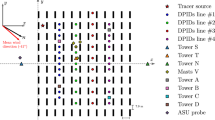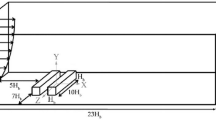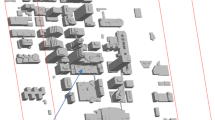Abstract
Risk assessment, city planning, and emergency response are a few examples of potential applications of numerical simulations of scalar dispersion in urban environments. The complex flow fields and scalar dispersion are determined by the building layout and prevailing meteorological conditions that are highly uncertain. While the fidelity of a numerical model is important in providing an accurate prediction of flow and scalar fields, propagating the uncertain input through numerical models is imperative in those applications. However, it is uncommon to quantify input uncertainties due to expensive computational cost of high fidelity simulations such as large eddy simulations (LES) and Reynolds-averaged Navier–Stokes (RANS). In this work, the uncertain meteorological quantities viz., wind speed and its direction from field measurements are taken as inputs to RANS simulations that use realizable \(k-\varepsilon\) turbulence model, to investigate their effects on passive scalar dispersion in central London. The mean wind and scalar quantities from RANS are initially validated with wind-tunnel data and compared to large eddy simulations (LES). For comparison with field measurements, the deduced probability density function (pdf) for wind speed and direction from the field are used as inputs for RANS simulations. For a 3-min averaged concentration at a specific receiver location, LES with unsteady wind inputs showed better performance than LES with mean wind input and RANS whereas for 30-min averaged concentration at various receiver locations, performance measures indicated that RANS is better than LES. The latter certainly suggests the importance of considering such uncertainties. The flow variability in every street is quantified using RANS simulations. This demonstrated that approximations used in a fast, low-order street network model may not be necessarily valid for every street of heterogeneous urban canopies, which in turn affects scalar prediction.
















Similar content being viewed by others
Ddata availability
The data will be provided upon request.
Code availability
The code used is opensource software.
Abbreviations
- C :
-
Concentration of scalar
- \(C^*\) :
-
Normalised scalar concentration
- h :
-
Building height
- \(h_m\) :
-
Mean building height
- k :
-
Turbulent kinetic energy
- \(k_m\) :
-
Molecular diffusivity
- \(k_t\) :
-
Turbulent diffusivity
- \(M_\ell\) :
-
Reference mesh where \(\ell =0,1,2\) in increasing order of mesh resolution
- \(\mathcal {N}\) :
-
Sample size
- p :
-
Pressure
- \(Q_S\) :
-
Volumetric source
- \(R_n\) :
-
Receiver locations
- s :
-
Street index
- \(S_m\) :
-
Source locations
- \(Sc_m\) :
-
Molecular Schmidt number
- \(Sc_t\) :
-
Turbulent Schmidt number
- t :
-
Time
- \(\textbf{u}\) :
-
Velocity magnitude
- \(u_*\) :
-
Surface friction velocity
- \(u_d\) :
-
Bulk exchange mass velocity
- \(\textbf{u}_{BT}\) :
-
\(\textbf{u}\) at BT tower height
- \(\textbf{u}_{hm}\) :
-
\(\textbf{u}\) at mean building height
- \(\textbf{u}_{ref}\) :
-
\(\textbf{u}\) at reference height
- \(\textbf{u}_{s}\) :
-
Street channel velocity
- \(\textbf{u}_{zmax}\) :
-
\(\textbf{u}\) at free stream height
- \(\mathcal {V}_s\) :
-
Volume of street canyon, s
- z :
-
Vertical coordinate or height from ground
- \(z_0\) :
-
Aerodynamic roughness length
- \(\epsilon\) :
-
Mesh convergence error
- \(\varepsilon\) :
-
Turbulence dissipation rate
- \(\kappa\) :
-
Von Karman constant
- \(\nu\) :
-
Kinematic viscosity
- \(\nu _t\) :
-
Turbulent viscosity
- \(\rho\) :
-
Density
- \(\sigma _w\) :
-
Standard deviation of the vertical velocity at roof level
- \(\sigma _{\phi _{s}}\) :
-
Standard deviation of \(\langle \phi \rangle _{s}\) from \(\overline{\phi }_{s}\)
- \(\varsigma _{s}\) :
-
Standard deviation of velocity magnitude in street s
- \(\phi _{s}\) :
-
Velocity component of street, s where \(\phi = u,v,w\)
- \(\overline{\varsigma }_{s}\) :
-
Ensemble average of \(\varsigma _{s}\)
- \(\langle \phi \rangle _{s}\) :
-
Volume average of \(\phi_{s}\)
- \(\overline{\phi }_{s}\) :
-
Ensemble average of \(\phi _{s}\)
- \(\omega\) :
-
Specific dissipation rate
- ANOVA:
-
Analysis of variance
- BT:
-
British Telecom
- CFD:
-
Computational fluid dynamics
- CI:
-
Confidence interval
- ClearfLo:
-
Clean Air for London
- DNS:
-
Direct numerical simulations
- LBM:
-
Lattice Boltzmann method
- LES:
-
Large eddy simulations
- LiDAR:
-
Light Detection and Ranging
- MRI:
-
Magnetic resonance imaging
- NAD:
-
Normalised absolute difference
- NMSE:
-
Normalised mean square error
- pdf:
-
Probablity density function
- POD:
-
Proper orthogonal decomposition
- QoI:
-
Quantities of interest
- RANS:
-
Reynolds-Averaged Navier–Stokes
- SDG:
-
Sustainable Development Goals
- UQ:
-
Uncertainty quantification
- VLES:
-
Very large eddy simulations
- WCC:
-
Westminster City Council
- AERMOD:
-
American Meteorological Society/Environmental Protection Agency Regulatory Model
- CALPUFF:
-
California puff model
- Dakota:
-
Design Analysis Kit for Optimization and Terascale Applications
- DAPPLE:
-
Dispersion of air pollution and its penetration into the local environment
- EPSRC:
-
Engineering and physical sciences research council
- QUIC:
-
Quick Urban and Industrial Complex
References
Adams B, Ebeida MM.S.and Eldred, Jakeman J, et al (2014) Dakota, a multilevel parallel object-oriented framework for design optimization, parameter estimation, uncertainty quantification, and sensitivity analysis version 6.7 Theory Manual. Sandia Technical Report SAND2014-4633, July https://dakota.sandia.gov/sites/default/files/docs/6.7/https://www.overleaf.com/project/6390585fa8af79090b800e62Theory-6.7.0.pdf
Arnold S, ApSimon H, Barlow J et al (2004) Introduction to the DAPPLE air pollution project. Sci Total Environ 332:139–153. https://doi.org/10.1016/j.scitotenv.2004.04.020
Balogun AA, Tomlin AS, Wood CR et al (2010) In-street wind direction variability in the vicinity of a busy intersection in central London. Bound-Layer Meteorol 136:489–513. https://doi.org/10.1007/s10546-010-9515-y
Barlow J, Dobre A, Smalley RJ et al (2009) Referencing of street-level flows measured during the DAPPLE 2004 campaign. Atmos Environ 43(34):5536–5544. https://doi.org/10.1016/j.atmosenv.2009.05.021
Blocken B, Vervoort R, van Hooff T (2016) Reduction of outdoor particulate matter concentrations by local removal in semi-enclosed parking garages: a preliminary case study for Eindhoven city center. J Wind Eng Ind Aerodyn 159:80–98. https://doi.org/10.1016/j.jweia.2016.10.008
Bohnenstengel SI, Belcher SE, Aiken A et al (2015) Meteorology, air quality, and health in London: the ClearfLo project. Bull Am Meteorol Soc 96:779–804. https://doi.org/10.1175/BAMS-D-12-00245.1
Carpentieri M, Robins AG, Baldi S (2009) Three-dimensional mapping of air flow at an urban canyon intersection. Bound-Layer Meteorol 133:277–296. https://doi.org/10.1007/s10546-009-9425-z
Carpentieri M, Salizzoni P, Robins A et al (2012) Evaluation of a neighbourhood scale, street network dispersion model through comparison with wind tunnel data. Environ Model Softw 37:110–124. https://doi.org/10.1016/j.envsoft.2012.03.009
Cimorelli A, Perry S, Venkatram A et al (2004) AERMOD: Description of model formulation. Technical Report, United States Environmental Protection Agency
Coceal O, Goulart E, Branford S et al (2014) Flow structure and near-field dispersion in arrays of building-like obstacles. J Wind Eng Ind Aerodyn 125:52–68. https://doi.org/10.1016/j.jweia.2013.11.013
Fellini S, Salizzoni P, Ridolfi L (2021) Vulnerability of cities to toxic airborne releases is written in their topology. Sci Rep. https://doi.org/10.1038/s41598-021-02403-y
García-Sánchez C, Gorlé C (2018) Uncertainty quantification for microscale CFD simulations based on input from mesoscale codes. J Wind Eng Ind Aerodyn 176:87–97. https://doi.org/10.1016/j.jweia.2018.03.011
García-Sánchez C, Van Tendeloo G, Gorlé C (2017) Quantifying inflow uncertainties in RANS simulations of urban pollutant dispersion. Atmos Environ 161:263–273. https://doi.org/10.1016/j.atmosenv.2017.04.019
Grylls T, Le Cornec CMA, Salizzoni P et al (2019) Evaluation of an operational air quality model using large-eddy simulation. Atmos Environ X 3(100):041. https://doi.org/10.1016/j.aeaoa.2019.100041
Hanna S, Chang J (2012) Acceptance criteria for urban dispersion model evaluation. Meteorol Atmos Phys 116:133–146. https://doi.org/10.1007/s00703-011-0177-1
Hargreaves DM, Wright NG (2007) On the use of the \(k-\varepsilon\) model in commercial CFD software to model the neutral atmospheric boundary layer. J Wind Eng Ind Aerodyn 95:355–369. https://doi.org/10.1016/j.jweia.2006.08.002
Hertwig D, Soulhac L, Fuka V et al (2018) Evaluation of fast atmospheric dispersion models in a regular street network. Environ Fluid Mech 18:1007–1044. https://doi.org/10.1007/s10652-018-9587-7
Huang ZR, Zhang YJ, Wen YB et al (2022) Synoptic wind driven ventilation and far field radionuclides dispersion across urban block regions: effects of street aspect ratios and building array skylines. Sustain Cities Soc 78(103):606. https://doi.org/10.1016/j.scs.2021.103606
Jurado X, Reiminger N, Vazquez J et al (2021) On the minimal wind directions required to assess mean annual air pollution concentration based on CFD results. Sustain Cities Soc 71(102):920. https://doi.org/10.1016/j.scs.2021.102920
Keshavarzian E, Jin R, Dong K et al (2021) Effect of building cross-section shape on air pollutant dispersion around buildings. Build Environ 197(107):861. https://doi.org/10.1016/j.buildenv.2021.107861
Lim H, Hertwig D, Grylls T et al (2022) Pollutant dispersion by tall buildings: laboratory experiments and Large-Eddy Simulation. Exp Fluids. https://doi.org/10.1007/s00348-022-03439-0
Liu Z, Barlow JF, Chan PW et al (2019) A review of progress and applications of pulsed Doppler wind LiDARs. Remote Sens 11:2522. https://doi.org/10.3390/rs11212522
Lucas DD, Gowardhan A, Cameron-Smith P et al (2016) Impact of meteorological inflow uncertainty on tracer transport and source estimation in urban atmospheres. Atmos Environ 143:120–132. https://doi.org/10.1016/j.atmosenv.2016.08.019
Margheri L, Sagaut P (2016) A hybrid anchored-ANOVA-POD/Kriging method for uncertainty quantification in unsteady high-fidelity CFD simulations. J Comput Phys 324:137–173. https://doi.org/10.1016/j.jcp.2016.07.036
OpenFOAM (2020) https://www.openfoam.com/news/main-news/openfoam-v20-12. Accessed Jan 2021
Pardyjak E, Brown M (2003) QUIC-URB v.1.1: theory and users guide. Report LA-UR-07-3181. Los Alamos National Laboratory, Los Alamos, NM, USA
Ricci A, Kalkman I, Blocken B et al (2020) Impact of turbulence models and roughness height in 3D steady RANS simulations of wind flow in an urban environment. Build Environ 171(106):617. https://doi.org/10.1016/j.buildenv.2019.106617
Scire J, Strimaitis D, Yamartino R (2000) A user’s guide for CALPUFF dispersion model (Version 5). Technical Report, Earth Tech Inc URL http://www.src.com/calpuff/download/CALPUFF_UsersGuide.pdf
Shim G, Prasad D, Elkins C et al (2019) 3D MRI measurements of the effects of wind direction on flow characteristics and contaminant dispersion in a model urban canopy. Environ Fluid Mech 19:851–878. https://doi.org/10.1007/s10652-019-09676-y
Soulhac L, Salizzoni P, Cierco FX et al (2011) The model SIRANE for atmospheric urban pollutant dispersion; part I, presentation of the model. Atmos Environ 45(39):7379–7395. https://doi.org/10.1016/j.atmosenv.2011.07.008
Soulhac L, Salizzoni P, Mejean P et al (2012) The model SIRANE for atmospheric urban pollutant dispersion; PART II, validation of the model on a real case study. Atmos Environ 49:320–337. https://doi.org/10.1016/j.atmosenv.2011.11.031
Soulhac L, Salizzoni P, Mejean P et al (2013) Parametric laws to model urban pollutant dispersion with a street network approach. Atmos Environ 67:229–241. https://doi.org/10.1016/j.atmosenv.2012.10.053
Soulhac L, Lamaison G, Cierco FX et al (2016) SIRANERISK: modelling dispersion of steady and unsteady pollutant releases in the urban canopy. Atmos Environ 140:242–260. https://doi.org/10.1016/j.atmosenv.2016.04.027
Soulhac L, Nguyen C, Volta P et al (2017) The model SIRANE for atmospheric urban pollutant dispersion. PART III: validation against NO2 yearly concentration measurements in a large urban agglomeration. Atmos Environ 167:377–388. https://doi.org/10.1016/j.atmosenv.2017.08.034
Tominaga Y, Iizuka S, Imano M et al (2013) Cross comparisons of CFD results of wind and dispersion fields for MUST experiment: evaluation exercises by AIJ. J Asian Archit Build Eng. https://doi.org/10.3130/jaabe.12.117
United Nations (n.d.) Take action for the sustainable development goals - United Nations Sustainable Development. https://www.un.org/sustainabledevelopment/sustainable-development-goals/. Accessed 4 Aug 2022
Volpiani PS, Meyer M, Franceschini L et al (2021) Machine learning-augmented turbulence modeling for RANS simulations of massively separated flows. Phys Rev Fluids 6(064):607. https://doi.org/10.1103/PhysRevFluids.6.064607
Wang A, Fallah-Shorshani M, Xu J et al (2016) Characterizing near-road air pollution using local-scale emission and dispersion models and validation against in-situ measurements. Atmos Environ 142:452–464. https://doi.org/10.1016/j.atmosenv.2016.08.020
Wieringa J (1992) Updating the Davenport roughhness classification. J Wind Eng Ind Aerodyn 41–44:357–368. https://doi.org/10.1016/0167-6105(92)90434-C
Wise DJ, Boppana VBL, Li KW et al (2018) Effects of minor changes in the mean inlet wind direction on urban flow simulations. Sustain Cities Soc 37:492–500. https://doi.org/10.1016/j.scs.2017.11.041
Wood C, Arnold SJ, Balogun AA et al (2009) Dispersion experiments in Central London: the 2007 DAPPLE project. Bull Am Meteor Soc 90:955–970. https://doi.org/10.1175/2009BAMS2638.1
Xie ZT (2011) Modelling street-scale flow and dispersion in realistic winds-towards coupling with mesoscale meteorological models. Bound-Layer Meteorol 141:53–75. https://doi.org/10.1007/s10546-011-9629-x
Xie ZT, Castro I (2006) LES and RANS for turbulent flow over arrays of wall mounted cubes. Flow Turbul Combust 76:291–312. https://doi.org/10.1007/s10494-006-9018-6
Xie ZT, Castro IP (2009) Large-eddy simulation for flow and dispersion in urban streets. Atmos Environ 43:2174–2185. https://doi.org/10.1016/j.atmosenv.2009.01.016
Acknowledgements
The authors would like to thank Dr. Zheng-Tong Xie of University of Southampton, U.K. and Prof. Alan G Robins of University of Surrey, U.K. for sharing DAPPLE geometry information.
Funding
Not applicable
Author information
Authors and Affiliations
Contributions
BB: Conceptualization, Simulation, Data analysis, Methodology, Writing—draft, review & editing. VTN: Conceptualization, Methodology, Data analysis discussions, Writing—review & editing. DW: Geometry creation, Data analysis discussions, Writing—review. JL: Dakota testing, Data analysis discussion, Writing—review & editing.
Corresponding author
Ethics declarations
Conflict of interest
The authors have no conflict of interest.
Ethics approval
Not applicable.
Consent to participate
Not applicable.
Consent for publication
Not applicable.
Additional information
Publisher's Note
Springer Nature remains neutral with regard to jurisdictional claims in published maps and institutional affiliations.
Appendix A Coordinates of source and receiver locations
Appendix A Coordinates of source and receiver locations
Rights and permissions
Springer Nature or its licensor (e.g. a society or other partner) holds exclusive rights to this article under a publishing agreement with the author(s) or other rightsholder(s); author self-archiving of the accepted manuscript version of this article is solely governed by the terms of such publishing agreement and applicable law.
About this article
Cite this article
Boppana, B., Nguyen, VT., Wise, D.J. et al. Uncertainty quantification of inflow on passive scalar dispersion in an urban environment. Environ Fluid Mech 23, 661–687 (2023). https://doi.org/10.1007/s10652-023-09927-z
Received:
Accepted:
Published:
Issue Date:
DOI: https://doi.org/10.1007/s10652-023-09927-z




